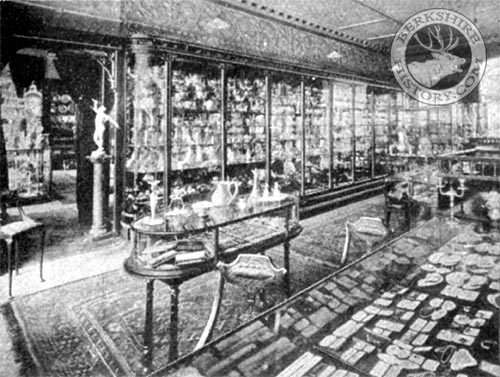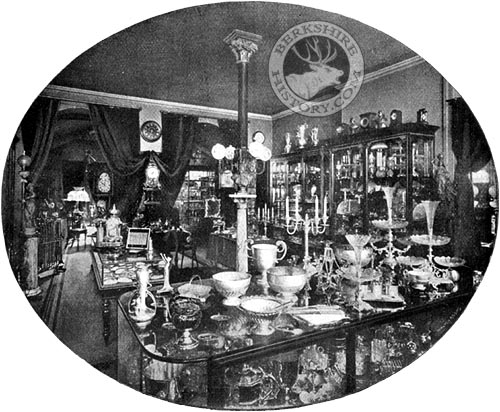 |
 |
|||
|
The well-known Reading jewellery firm of Bracher & Sydenham long claimed to have been founded at No 55 Minster Street by James Trendell in 1790. However, this is not the case. The business was begun, some time prior to 1789, by Charles Packer (1747-1808) in Castle Street. He was a descendant of the Packers of Cricklade & Cheltenham, cousins and founder’s kin to Sir Thomas White of Reading who established St. John’s College, Oxford in the 16th century; as well as of the Packers of Shellingford, Donnington & Bucklebury. It was in February 1789 that he announced, "he is removed from Castle Street to Minster Street, near the George Inn, Reading, where he continues to make and sell all sorts of clocks, watches, silver and jewellery, on the very best principle, and reasonable rates… Mr. Cahusac, musical instrument maker, having left the above shop to be with his father in London, the public may be supplied with everything in the musical line as before by their humble servant Charles Packer" Thomas Cahusac entered into partnership with his father at No 196 The Strand, facing St. Clement Danes' Church. He had only been in Minster Street - apparently at No 5 - since February 1786, when he begged “leave to acquaint the public, that he has taken the shop next door to Mr. Lyne's, Minster Street, Reading, which will be opened as soon as possible it can fitted up for selling all sorts of music and musical instruments. Mrs. Cahusac having taught harpsichord and piano forte, for upwards of 12 years, begs leave to offer her service to the ladies of Reading and its neighbourhood, and doubts not but they will find her character and knowledge of the above instruments to be such as will insure their kind encouragement and protection…. Mrs Cahusac will wait on any lady or family immediately, by applying to Mrs. Saunders, milliner, at the same shop.” She also taught the German flute, violin and oboe. The music shop opened by the end of March, promising "The public may be supplied with every article in the musical way, wholesale and retail as cheap as in London." The same year that Charles Packer moved his clock & watch-making, silversmith, jewellery & engraving business to Minster Street, his third son, Richard Taylor Packer, was born (sadly he only lived to the age of seven). He was named after the father’s friend and, about four years later, his business partner, Richard Taylor. Packer & Taylor only lasted a few years, however, and the partnership was dissolved in October 1797 Taylor opened a similar business, minus the music department, at 3 Butcher Row. Packer remained in Minster Street.
In 1839, Reuben Bracher (1825-1888) was apprenticed for seven years to a watchmaker in his home town of Salisbury. It is not clear exactly when he joined the Reading jeweller’s shop, but he became a partner in Trendall & Bracher’s in 1852. James Trendell retired in 1855 and his name was dropped from the business. Reuban seems to have also been trained in the Trendell hairdressing business and initially also advertised himself as a ‘hair artist’. In 1874, he joined in partnership with his nephew,
Joseph Sydenham (1846-1913) (a founder & first secretary of Reading Football Club), and Bracher & Sydenham moved to a new shop next door, opening in April the following year. It was a thriving business throughout the late 19th century and gained a national reputation, largely thanks to the silverware that their craftsmen produced for VIPs visiting
Huntley and Palmer’s biscuit factory. This
|
|||
| © Nash Ford Publishing 2017. All Rights Reserved. | ||||






 Bracher &
Sydenham Jeweller's
Bracher &
Sydenham Jeweller's By 1812, Charles Packer’s eldest son, John (1784-1855), had taken over the jewellery and silversmith side of the business; while his second son, Charles (1786-1854), ran the musical instrument department. In 1815, a few years after the death of Charles Senior, John Packer appears to have sold off his side of the business to James Trendell (1790-1866) and moved to
By 1812, Charles Packer’s eldest son, John (1784-1855), had taken over the jewellery and silversmith side of the business; while his second son, Charles (1786-1854), ran the musical instrument department. In 1815, a few years after the death of Charles Senior, John Packer appears to have sold off his side of the business to James Trendell (1790-1866) and moved to
 was further enhanced by personal visits to the shop from King Edward VII,
who granted them the Royal warrant, his sister, Princess Christian of Schleswig-Holstein, and, later, Queen Mary. By 1886, the firm was doing so well that they were able to expand out again to cover both No 55 & 56. Eight years later, they stretched all the way to No 58, almost on the corner of Yield Hall Lane. Their optical department was added in June 1899. With the decline of Minster Street, however, the business relocated to 26-28 Queen Victoria Street in 1924. From the 1940s, Bracher & Sydenham expanded into antique silver and jewellery, and in the following two decades, they proudly displayed their wares in six large showrooms, all lit by gas. People would put on their Sunday best to visit the shop and, even up until 1983, they had a doormen to welcome customers. In 1972, upon the death of Colonel Crouch of Cardiff, the family finally sold the company to Norman Martin and Felix Pole, of the auctioneers Martin & Pole, who wanted to keep the old Reading firm going. They moved to No 24 Queen Victoria Street in 1974 and, soon afterwards, they became part of the Goldsmiths chain. Since the opening of the Oracle Shopping Centre, Goldsmiths have moved to 21D Holy Brook Walk.
was further enhanced by personal visits to the shop from King Edward VII,
who granted them the Royal warrant, his sister, Princess Christian of Schleswig-Holstein, and, later, Queen Mary. By 1886, the firm was doing so well that they were able to expand out again to cover both No 55 & 56. Eight years later, they stretched all the way to No 58, almost on the corner of Yield Hall Lane. Their optical department was added in June 1899. With the decline of Minster Street, however, the business relocated to 26-28 Queen Victoria Street in 1924. From the 1940s, Bracher & Sydenham expanded into antique silver and jewellery, and in the following two decades, they proudly displayed their wares in six large showrooms, all lit by gas. People would put on their Sunday best to visit the shop and, even up until 1983, they had a doormen to welcome customers. In 1972, upon the death of Colonel Crouch of Cardiff, the family finally sold the company to Norman Martin and Felix Pole, of the auctioneers Martin & Pole, who wanted to keep the old Reading firm going. They moved to No 24 Queen Victoria Street in 1974 and, soon afterwards, they became part of the Goldsmiths chain. Since the opening of the Oracle Shopping Centre, Goldsmiths have moved to 21D Holy Brook Walk.